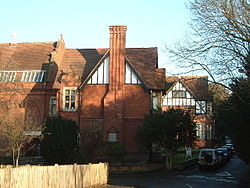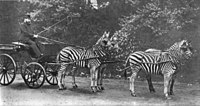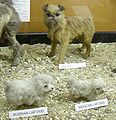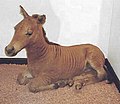Difference between revisions of "Natural History Museum at Tring"
(Created page with "{{Infobox building |name=Natural History Museum at Tring |county=Hertfordshire |picture=Rothschild Museum Tring.jpg |picture caption=The Rothschild Natural History Museum, Tri...") |
(No difference)
|
Latest revision as of 15:41, 28 December 2018
| Natural History Museum at Tring | |
|
Hertfordshire | |
|---|---|
 The Rothschild Natural History Museum, Tring | |
| Type: | Museum |
| Location | |
| Grid reference: | SP92421109 |
| Location: | 51°47’27"N, 0°39’41"W |
| Town: | Tring |
| History | |
| Address: | Akeman Street |
| Museum | |
| Information | |
| Website: | //nhm.ac.uk/tring/ |
The Natural History Museum at Tring stands on Akeman Street, at the edge of Tring in Hertfordshire. It was originally the private museum of Lionel Walter, 2nd Baron Rothschild; today it is under the control of the Natural History Museum, London. The museum houses one of the finest collections of stuffed mammals, birds, reptiles and insects in the United Kingdom, in a house which was once the Rothschild family home.
The museum was first known as the ‘Walter Rothschild Zoological Museum’, but in April 2007 the Natural History Museum changed its name.[1]
Contents
History
The Natural History Museum at Tring was once the private museum of Lionel Walter Rothschild, 2nd Baron Rothschild. It is located in the grounds of the former Rothschild family home of Tring Park. The building seen today was constructed in 1889 to house his collection of mounted specimens and first opened to the public in 1892. The Rothschild family gave the Museum and its contents to the nation in 1937, at which time it became part of the British Museum’s natural history collection, now the Natural History Museum.[1] Lord Rothschild bred hybrids between zebras and horses (zebroids) and a hybrid foal is on display. He was frequently seen riding a zebra-drawn carriage; the museum's Zebra Café alludes to Lord Rothschild's love of zebras and has photographs of his trained zebras harnessed to open carriages.[2]
Description
The extensive collection, housed in several rooms, includes extinct animals and birds such as the quagga, thylacine, great auk and reconstructions of the moa and dodo. Oddities include hybrids and examples of abnormal coloration.
The dogs display was relocated to the Rothschild Zoological Museum from the Natural History Museum, South Kensington, Middlesex after the Second World War: this shows how domestic dogs have changed shape due to selective breeding and includes the tiny Russian and Mexican lapdogs as well as famous racing greyhounds.
The Museum has six galleries, each one of which houses a different set of animals. The first gallery contains birds, large carnivorans and primates, the second is used to show temporary exhibits, the third crocodilians, crustaceans, fishes, insects, large mammals and marine invertebrates, the fourth accommodates kangaroos and odd-toed ungulates, the fifth holds bovids, hippopotamuses, pigs and marine mammals, and finally the sixth gallery contains amphibians, bats, various British mammals, domestic dogs, ratites, lizards, snakes, turtles and small mammals.
The Museum also contains a Discovery Room, designed for young children and the Rothschild Room which is a room set out to recreate the surroundings in which the Rothschild family would have worked.[1]
The site is also home to the ornithological research collections (Bird Group, Department of Zoology) and the ornithological library (Department of Library and Information Services) of The Natural History Museum, but these are not open to the public. There are small special themed exhibitions throughout the year showcasing specimens not normally on display, as well as activities for youngsters.[1]
Thefts from the museum
On 24 June 2009 a theft occurred from the museum involving removal of 299 brightly coloured stuffed birds, mostly male trogons and quetzals from Central and South America, as well as birds of paradise from the island of New Guinea some of which had been collected by Alfred Russel Wallace.[3]. In November 2010, Edwin Rist, an American studying at The Royal Academy of Music, was arrested and pleaded guilty. The majority of bird skins were recovered.[4][5] Rist was given a 12-month suspended sentence and was required to repay £125,150; the estimated proceeds from selling the skins through such outlets as eBay. The police also advised that 191 intact bird skins had so far been recovered, of which only 101 had labels recording the birds' key scientific data.[6]
In the early hours of 27 August 2011 a thief broke in through the museum's front doors and removed the horns from two rhinoceros exhibits, one Indian rhino the other a white rhino, using, it was believed a large hammer. However, in the light of recent thefts from other museums, three months before the break-in, curators had replaced the real rhino horns, valued at £240,000, with replica ones made from resin which had no commercial value.[7] In January 2012, Darren Bennett from Leicester was charged with the theft.[8]
Picture gallery
Outside links
| ("Wikimedia Commons" has material about Natural History Museum at Tring) |
- The Natural History Museum at Tring
- The Walter Rothschild Zoological Museum - Tring Information Centre
- Photograph of Museum exterior
References
- ↑ 1.0 1.1 1.2 1.3 About the Natural History Museum at Tring, Accessed 16-08-2016
- ↑ Zebra-drawn carriage driven by Lord Lionel Walter Rothschild
- ↑ Pimm, Stuart (17 April, 2018). When feathers flew at a natural-history archive ‘’Nature’’
- ↑ ’Arrest over theft of 299 rare bird skins in Tring’: BBC News online
- ↑ ’Flute player admits theft of 299 rare bird skins’: BBC News online
- ↑ ’Natural History Museum thief ordered to pay thousands’: BBC online
- ↑ ’Rhino horn raiders steal replicas from Tring museum’: BBC News online
- ↑ ’Tring museum replica rhino horn theft: Man charged’: 'BBC News online
Books
- 'Dear Lord Rothschild: Birds, Butterflies and History' ISBN 0-86689-019-X
- Johnson, Kirk Wallace: 'The Feather Thief: Beauty, Obsession and the Natural History Heist of the Century'





